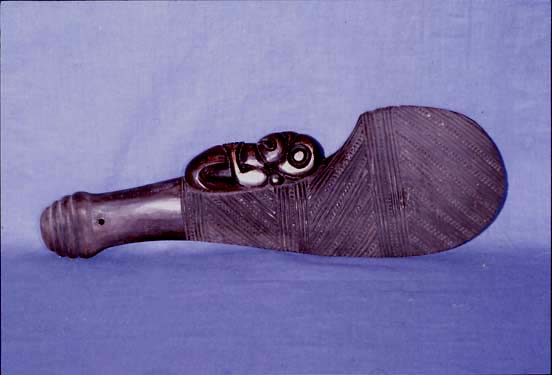
Click here to view image
chiefs' club Patu Wahaika
Enrico A. D'Albertis 1932
New Zeland, second half of the 19th century
XIX - 1851 - 1900
C.D.A. 492
Tipo di misura: altezzaxlarghezzaxspessore; Unità di misura: cm; Valore: 36x12.7x2
Nuova Zelanda
Wood
Cerimoniale/difensiva/offensiva Portata alla cintura, veniva tenuta con una mano e usata nei combattimenti e nelle cerimonie. Il fendente veniva inferto con il bordo convesso della lama. Cerimonie/combattimenti
Sickle-shaped Maori flat mace with a carved handle adorned with three convexities. The surfaces are decorated in carving with groups of three lines alternating with triangles in relief, arranged on three oblique registers separated from each other by three horizontal bands. Along the inner side of the weapon is carved a stylised figure symbolising a mythological spirit linked to the weapon's spiritual power (mana), which increased in proportion to success in combat. The figure has circular earrings, eyes, a nose and a beak-like mouth from which a tongue protrudes; intertwined tridactile hands clasp the shapeless body. Experts in hand-to-hand combat, the Maoris have devised a wide variety of short clubs carved out of wood - broadly known as patu - designed to deliver sudden, powerful blows from the top down. The wahaika is a distinct type of patu worn daily on the belt, which means 'fish mouth'. These weapons were passed down from generation to generation as family heirlooms.
The multiplication of curvilinear motifs, spirals, and the coverage of the entire surface with fretwork or engraved decorations is characteristic of Maori production, in particular in wood. Historically Maori art has been described by referencing the characteristics of its external appearance. However, more recently the publication of works by Maori scholars has provided interpretations and insights that reveal the complexity of plastic symbols in social, political and religious systems that must be understood in their entirety.




